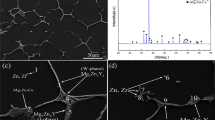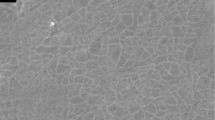Abstract
Hexagonal close-packed (HCP) magnesium metals are widely used in different industries due to their low density and high specific strength. Their applicability is restricted due to poor formability and pronounced plastic anisotropy. Commonly, the formability is improved by altering the chemistry (adding rare-earth elements like Y) or modulating the microstructure (e.g., grain refinement). Grain refinement alone cannot yield the desired ductility, and the scarcity of rare-earth elements also limits the alloying addition. In this work, using the crystal plasticity framework, the combined effect of Y-content and grain size on the mechanical responses of Mg alloy is studied. The influence of alloying is represented by varying the activation stress and hardening responses of basal, prismatic, pyramidal slip, and tensile twin systems. This detailed study provides a map of strength and tension–compression asymmetry for a wide range of Y-content and grain sizes. This work provides a pathway to optimize the microstructure and chemistry to achieve excellent structural properties.
Access provided by Autonomous University of Puebla. Download conference paper PDF
Similar content being viewed by others
Keywords
Extended Abstract
Hexagonal close-packed (HCP) magnesium (Mg) and derivative alloys are widely used for lightweight transportation due to their low density and high specific strength [1]. However, poor formability at room temperature limits their widespread use in many applications. The low formability of Mg is a consequence of its pronounced plastic anisotropy [2, 3]. The plastic deformation in Mg and its alloys is accommodated by a combination of basal \(\langle a \rangle \) , prismatic \(\langle a \rangle \) , and pyramidal \(\langle c+ a \rangle \) slip, along with deformation twinning [4]. The activation barrier or critical resolved shear stresses (CRSS) for each slip dislocation mode is significantly different. In turn, a crystal oriented to activate one set of slip systems can have a different plastic response than another crystal oriented to activate another set of slip systems. Further, the deformation twinning is directionally dependent, so the deformation twins accommodate either c-axis contraction or extension but not both. The anisotropy in CRSS values and directional dependency leads to a pronounced tension–compression asymmetry, which limits the material’s formability.
Grain refinement, texture control, and alloying are commonly considered potential strategies to improve the formability of Mg by reducing the dissimilarities in the CRSS among slip modes and suppressing direction-dependent twinning. Reducing the grain size has been found to suppress twinning activity and increase formability [2, 5]. The crystallographic texture is modified, specifically the texture weakening, via alternative metal processing techniques, such as asymmetric rolling and equal channel angular pressing to improve the formability [6, 7]. Finally, the additions of rare earth elements (Y, Ce, Nd, La, etc.) have been reported to lower plastic anisotropy significantly [8,9,10,11]. Among these three strategies, the alloying addition is known to be a viable way to improve formability. However, these alloying elements are not abundant and thus limit the applicability of these alloys. This work hypothesizes that this limitation can be overcome by combining the alloying method with the grain refinement strategy. That is, the minimum amount of rare-earth elements needed to improve the formability of Mg alloys can be reduced by properly tuning the grain size.
To capture the effect of grain size and Y-content on mechanical responses, a visco-plastic self-consistent (VPSC) crystal plasticity model is employed [12]. In the calculation, basal \(\langle a \rangle \), prismatic \(\langle a \rangle\), and pyramidal \(\langle c+a\rangle \) slip modes and \(\{10 \overline{1} 2 \}\) tensile twinning are assumed to accommodate the plastic deformation. The dislocation density-based hardening law is used [13]. The effect of grain sizes on slip and twinning is modeled through directional-dependent micro-Hall-Petch equations [14]. Following the classical works of [15,16,17], the alloying concentration is directly related to the strength terms for each slip and twinning mode. It allows us to directly capture the role of alloying elements on dislocation slip motion and deformation twinning. The stress–strain responses and twin volume fraction values reported in [18] for different Y content are used to calibrate and validate the model. The model-predicted mechanical responses for both rolling direction tension (RDT) and compression (RDC), along with the experimental values, are shown in Fig. 1a. The solid and dashed lines correspond to the model-predicted stress–strain response for RDC and RDT loadings, whereas the symbols refer to experiments. Note that the grain size is different for different Y-content cases. Overall, the developed correctly captures the twinning signature in the RDC loading and the complex dependence of Y content on slip and twinning activity for both RDC and RDT. The increase in Y-content lowers the tension–compression asymmetry at yield and also later in the strain hardening regime.
The developed model is further used to simulate the mechanical responses under tension and compression for a wide range of grain sizes and Y-content. The calculated tension–compression asymmetry at yield is plotted in the grain size and Y-content, see Fig. 1b. As one expects, the tension–compression asymmetry decreases with an increase in Y-content and a reduction in grain sizes. Interestingly, the distribution shown in Fig. 1b suggests that the Y-content can be reduced significantly with a slight to moderate decrease in grain sizes. For instance, the required reduction in grain size to lower the Y-content by 1% to achieve similar tension–compression asymmetry is only ~5 micron, which is feasible. Overall, this work establishes a plausible framework to optimize the microstructure (grain size) and Y-content to achieve desired structural properties such as strength and asymmetry.
References
M.K. Kulekci, International Journal of Advanced Manufacturing Technology 39(9–10) (2008) 851–865.
S.R. Agnew, O. Duygulu, International Journal of Plasticity 21(6) (2005) 1161–1193.
M.A. Kumar, I.J. Beyerlein, R.A. Lebensohn, C.N. Tome, Materials Science and Engineering a-Structural Materials Properties Microstructure and Processing 706 (2017) 295–303.
P.G. Partridge, Metallurgical Reviews 12 (1967) 169–194.
Q. Yu, L. Qi, R.K. Mishra, J. Li, A.M. Minor, Proceedings of the National Academy of Sciences 110(33) (2013) 13289–13293.
W. Kim, S. Hong, Y. Kim, S. Min, H. Jeong, J. Lee, Acta materialia 51(11) (2003) 3293–3307.
W. Kim, J. Lee, W. Kim, H. Jeong, H. Jeong, Scripta Materialia 56(4) (2007) 309–312.
T. Al-Samman, X. Li, Materials Science and Engineering: A 528(10–11) (2011) 3809–3822.
Chakkedath, J. Bohlen, S. Yi, D. Letzig, Z. Chen, C.J. Boehlert, Metallurgical and Materials Transactions A 45(8) (2014) 3254–3274.
Y. Chino, K. Sassa, M. Mabuchi, Materials Science and Engineering: A 513 (2009) 394–400.
H. Ding, X. Shi, Y. Wang, G. Cheng, S. Kamado, Materials Science and Engineering: A 645 (2015) 196–204.
R.A. Lebensohn, C.N. Tome, Acta Metallurgica Et Materialia 41(9) (1993) 2611–2624.
I.J. Beyerlein, C.N. Tome, International Journal of Plasticity 24(5) (2008) 867–895.
G. Proust, C.N. Tome, A. Jain, S.R. Agnew, International Journal of Plasticity 25(5) (2009) 861–880.
R. Labusch, physica status solidi (b) 41(2) (1970) 659–669.
R.L. Fleisgher, Acta metallurgica 9(11) (1961) 996–1000.
F. Nabarro, Philosophical magazine 35(3) (1977) 613–622.
J. Wang, X. Wang, K. Yu, T.J. Rupert, S. Mahajan, E.J. Lavernia, J.M. Schoenung, I.J. Beyerlein, Materials Science and Engineering: A 817 (2021) 141373.
Author information
Authors and Affiliations
Corresponding author
Editor information
Editors and Affiliations
Rights and permissions
Copyright information
© 2023 The Minerals, Metals & Materials Society
About this paper
Cite this paper
Arul Kumar, M., Wronski, M., Beyerlein, I.J. (2023). Combined Effect of Alloying and Grain Size on the Deformation Behavior of Magnesium Alloys. In: Barela, S., Leonard, A., Maier, P., Neelameggham, N.R., Miller, V.M. (eds) Magnesium Technology 2023. TMS 2023. The Minerals, Metals & Materials Series. Springer, Cham. https://doi.org/10.1007/978-3-031-22645-8_10
Download citation
DOI: https://doi.org/10.1007/978-3-031-22645-8_10
Published:
Publisher Name: Springer, Cham
Print ISBN: 978-3-031-22644-1
Online ISBN: 978-3-031-22645-8
eBook Packages: Chemistry and Materials ScienceChemistry and Material Science (R0)





